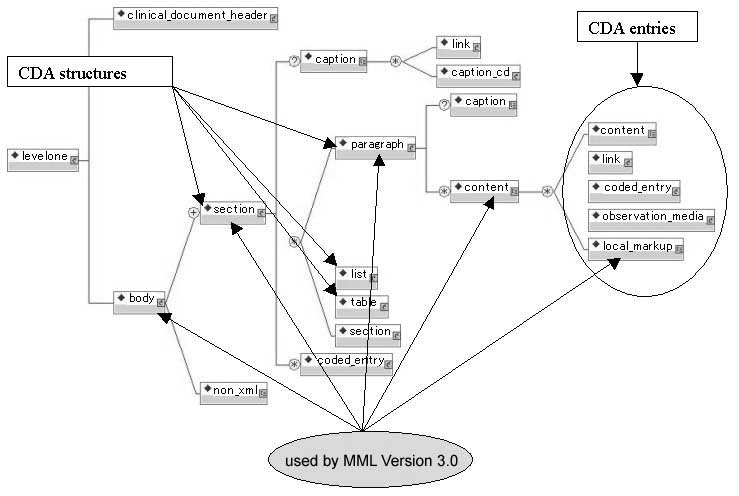6. Overview
6. 1. Clinical Document Architecture
The HL7 Version 3 Standard: Clinical Document Architecture Framework Release 1.0 (referred to as HL7 CDA hereafter) is a standard that defines the semantics of condition and the structure of “clinical documents” when exchanged via HL7 messages; it is a standard written in a set of XML (eXtensible Markup Language) documents. The HL7 CDA document contains the root element, “levelone”, and the subordinate elements that are comprised of the “clinical_document_header” called “CDA Header” and the “body” called “CDA Level One Body”. The “CDA Header” is derived from HL7 Reference Information Model (RIM) Version 0.98. Therefore, the messaging system is developed, referring to the same Reference Information Model (RIM) and based on the HL7 message creation method, HL7 V3 Message Development Framework (MDF) [12]. Consequently, messages are exchanged without any disagreement between the senders and receivers of messages; in other words, it is expected that both shall have the same context in communication. It is important here to keep in mind that the version of the RIM - named HL7 V3 RIM - can change. The existing ANSI-accredited standard HL7 CDA Release 1.0 employs Rim Version 0.98. When the version of the RIM employed by the HL7 CDA or the version of the HL7 CDA changes in future, a revised version of this standard shall be issued for parts affected by such changes.
The “CDA Header” includes elements to hold document information, diagnostic information, and information on the person engaged in medical care, and the target and targeted person of a medical service. Thus, the “CDA Header” specifies and classifies the document to be exchanged and provides diagnostic information and information on the person engaged in medical care, and the target and targeted person of a medical service. The document information includes elements such as <id> and <document_type_cd> used for identifying documents, elements such as <origination_dttm> used as time and date stamps for documents, and elements such as <provider> used for specifying more than one health care providers. As information on the target of a medical service, the <patient> element is included.
The “CDA Level One Body” includes a medical document. This means there is necessarily one <body> within <levelone> and that the structures (CDA Body structures) and entries (CDA body entries) are provided to hold the contents of XML which make up the medical document. The CDA Body structures include elements such as <section> and <paragraph> while the entries into which characteristic data can be input include elements such as <content> and <local_markup>.
The <section> element is a container which can have a nested structure and which may contain every kind of container. It is possible to have multiple <paragraph>s in the <section>, to have <content>s in the <paragraph> and <local_markup>s in the <content>.
For further information on the standard, please refer to the specification of the “Clinical Document Architecture Framework Release 1.0”. The illustrations below show the structure of the CDA Header: top level defined by the HL7 CDA and the structure of the CDA Level One Body.

